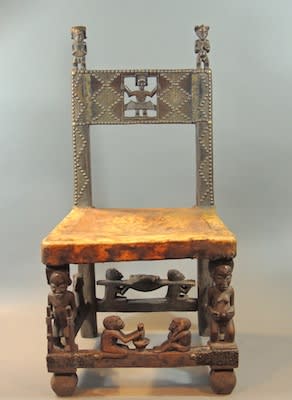Chokwe Throne/Chair, 20th Century CE
Leather/Wood/ Bronze
18 x 31.5
CB.001
Further images
An extremely well crafted piece. Leather stretched seat cover. Seat rail, chair legs and rungs elaborately ornamented with figurative scenes in high relief, featuring stylized ancestral figures and representations of...
An extremely well crafted piece. Leather stretched seat cover. Seat rail, chair legs and rungs elaborately ornamented with figurative scenes in high relief, featuring stylized ancestral figures and representations of everyday life.
The Chokwe kingdom rose to power during the late 19th century in the southern region of the Democratic Republic of Congo and northern Angola and thrived primarily by the profitable trade of ivory, wax and rubber with the Portuguese. In many societies of Central Africa functional artifacts are often transformed into prestigious court art, recalling and celebrating the power and status of the owner. Chokwe chairs follow the above practice and are among the few African objects not carved from a single piece of wood, as are instead assembled from different parts. Over the course of numerous encounters with European traders, Chokwe artisans appropriated the design of certain Western artifacts, such as these thrones, which are modeled upon European chairs with their elaborately decorated backs, leather-covered seats and decorative brass tacks.
The chair’s upright usually contains scenes or figures from the spiritual sphere, including representations of ancestors or chiefs.
On the centre of the back rail of this chair stands the principal character, an ancestral figure as protector of the tribe, with outstretched hands, among geometric carvings in low relief and brass tacks.
On either side of the back, two carved finials, a male and a female standing figure, representing prosperity and fertility in the form of Man and Woman.
The rows of figures along the crosspieces at the base of the chair are carved representations of domestic scenes from everyday life. These commonplace familiar scenes are encompassed into the general concept of “nourishment” as one of the King's obligations towards his realm, serving as a visual and a much more mundane juxtaposition to the ancestral sacred figures at the summit of the chair.
The figure of the Hunter holding a rifle, on the right leg of the chair, is also part of this concept of daily provision and “nourishment”.
On the front and side rungs feature scenes of the everyday family life, women tending to household activities or venerating sacred objects, while men are employed at work. The women in domestic activities are mostly reproduced collaborating in pounding grain and in the preparation of food. The overall organization of these scenes creates a uniform visual narrative, emphasizing the social harmony and continuity that is ultimately achieved through following the enlightened leadership of the chair's owner, namely, the chief.
On the back rung is represented a death scene, with the dead person carried on a sort of stretcher by two other figures. This seat of office, besides its obvious use and by incorporating such elaborate figurative scenes, could be considered as a symbolic microcosm of the Chokwe life. Provenance: the Herbert Baker Collection
The Chokwe kingdom rose to power during the late 19th century in the southern region of the Democratic Republic of Congo and northern Angola and thrived primarily by the profitable trade of ivory, wax and rubber with the Portuguese. In many societies of Central Africa functional artifacts are often transformed into prestigious court art, recalling and celebrating the power and status of the owner. Chokwe chairs follow the above practice and are among the few African objects not carved from a single piece of wood, as are instead assembled from different parts. Over the course of numerous encounters with European traders, Chokwe artisans appropriated the design of certain Western artifacts, such as these thrones, which are modeled upon European chairs with their elaborately decorated backs, leather-covered seats and decorative brass tacks.
The chair’s upright usually contains scenes or figures from the spiritual sphere, including representations of ancestors or chiefs.
On the centre of the back rail of this chair stands the principal character, an ancestral figure as protector of the tribe, with outstretched hands, among geometric carvings in low relief and brass tacks.
On either side of the back, two carved finials, a male and a female standing figure, representing prosperity and fertility in the form of Man and Woman.
The rows of figures along the crosspieces at the base of the chair are carved representations of domestic scenes from everyday life. These commonplace familiar scenes are encompassed into the general concept of “nourishment” as one of the King's obligations towards his realm, serving as a visual and a much more mundane juxtaposition to the ancestral sacred figures at the summit of the chair.
The figure of the Hunter holding a rifle, on the right leg of the chair, is also part of this concept of daily provision and “nourishment”.
On the front and side rungs feature scenes of the everyday family life, women tending to household activities or venerating sacred objects, while men are employed at work. The women in domestic activities are mostly reproduced collaborating in pounding grain and in the preparation of food. The overall organization of these scenes creates a uniform visual narrative, emphasizing the social harmony and continuity that is ultimately achieved through following the enlightened leadership of the chair's owner, namely, the chief.
On the back rung is represented a death scene, with the dead person carried on a sort of stretcher by two other figures. This seat of office, besides its obvious use and by incorporating such elaborate figurative scenes, could be considered as a symbolic microcosm of the Chokwe life. Provenance: the Herbert Baker Collection











